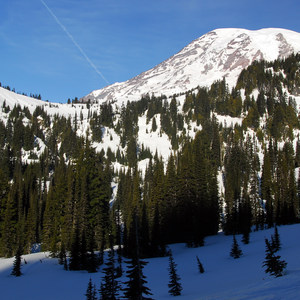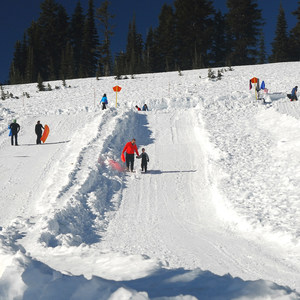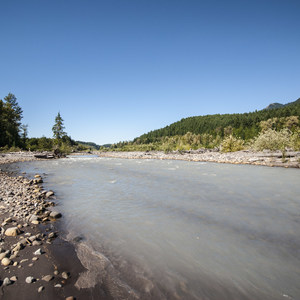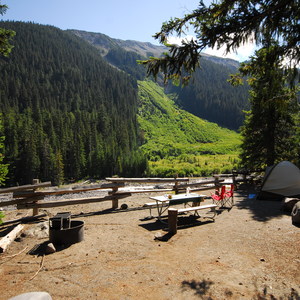You are here
Camp Muir is a storied location, perched at just over 10,000 feet on the southeast side of Mount Rainier, with far reaching views of the Cascade volcanoes to the south: Mount Adams, Mount St. Helens, Mount Hood, and even Mount Jefferson on a clear day.
Camp Muir is made up of a small group of stone shelters (and during the climbing season dozens of tents) to support mountaineers attempting to summit Rainier via its most commonly climbed route - the Disappointment Cleaver (DC). Camp Muir also acts as a dividing line on the DC - it is both halfway up the mountain vertically, and also marks the point at which climbers typically rope up, as the glaciers above Muir (Cowlitz + Ingraham) are much more heavily crevassed than the snowfields on the route below.
In the summer, this camp is a hive of activity and features a mix of dayhikers looking to push themselves at altitude and mountaineers who are preparing to voyage up the glaciated upper mountain. In the winter, the scene is a lot quieter. Instead of hundreds of people, sometimes as few as only 10 people make it to Camp Muir in a day and that's when the weather is good. In poor weather there's typically few to no one exploring this area of the mountain and for good reason.
However, if you're a backcountry skier, simply getting to Camp Muir isn't the draw. You're doing the climb because once you've gotten to Muir, you can ski one of the easiest to access 4,800 foot backcountry ski descents in the Lower 48. Once you rip your skins and transition, you'll be skiing all the way back down to your car, parked at Paradise Visitor Center, distantly visible from Camp Muir. Also attractive is the relatively moderate difficultly of the descent, pushing only 35 degrees at one point.
Despite the gradual grade, this backcountry ski trip isn't for beginners, as you'll have to continually assess weather and avalanche conditions, haul yourself up 4,800 feet of skinning, and still have enough gas left to get yourself down before the gate closure.
But if you have the experience, this trip is an absolute classic, and most decent days of weather will see skiers attempting this route.
Notes
Seasonality/Snow:
- When is there snow? Camp Muir can actually be skied year-round, thanks to the Muir Snowfield, which, while not a technical glacier, stays covered with snow/ice throughout the year. In midsummer, the snowfield generally stretches from around 7,200' to 10,000', However, if you're hoping to ski the Muir Snowfield in the summer, you'll need to haul your skis up ~2,000' of trail to get to the snow. Skiing Muir Snowfield is a lot more pleasant when the snow is continuous from the parking lot all the way up to the camp, which is generally the case from mid-November until late June.
- What is that snow like? Keep in mind that all snow is not equal, both in avalanche safety or in skiability.
- From August to October, you'll confront a snowpack that could be intermittent corn or miserable suncups and ice.
- From May through July, the snow will be less powdery and more isothermal, leading to icy conditions in the morning, corn at midday, and heading toward slop in the afternoon, with chances of wet slab or wet-loose avalanches with later-in-the-day descents.
- From ~January through May, you'll typically have a standard winter snowpack, which means more possibility of powder, but also more variable weather and avalanche conditions possible, including whiteouts, heavy winds, wind/storm slabs, etc.
- In November and December, you'll be facing thin snow coverage and early season hazards, like thinly covered creeks or holes in the snow.
- If all these terms and words are foreign to you, read up on ski mountaineering conditions. You need to know what you're getting into.
Routes
- Most skiers will ski up and down via the same route. However, if you're an experienced mountaineer and backcountry skier, comfortable skiing on active and crevassed glaciers and confident in your avalanche assessment skills, you can consider descending via the Nisqually Chute, which is more technical and steeper than the standard descent. It involves descending a 35-degree chute from 8,500 feet down to 6,300 feet, before skiing down the lower Nisqually Glacier. In mid-winter, you can ski all the way down to the road at 3,800 feet (making for a 6,200' descent), though you'll have to figure out how to get back up to your car at Paradise. In spring, when most people ski this line, you'll need to skin up ~400 feet to Glacier Vista.
Equipment
- Depending on when you're going and what the snow is like, you'll need certain equipment to keep you safe. Here's a short and not necessarily complete list of requirements and gear possibilities:
- Beacon, Shovel, Probe, Helmet, Ski gear: these are all essential.
- Ski Crampons: these aren't absolutely essential, but they're a good idea because it tends to get fairly wind-scoured up there.
- Crampons/Ice axe: depending on how icy it is, you may want these for the climb up Panorama Face.
- Your go to warm puffy for breaks/transitions.
- Headlamp- it gets dark early!
- A GPS (or GPS app on your phone) and the know-how to use it.
- Whatever other equipment you need to be safe and self-reliant at 10,000 feet.
Navigation
- Mount Rainier is a big mountain and makes its own weather. White-outs, due to fog, clouds, or snow, are common, especially up above 7,000 feet, and they can come out of nowhere, no matter what the "weather forecast" said.
- The route up to Camp Muir winds its way around and above cliffs above two large and heavily crevassed glaciers, Nisqually and Paradise. In the sunshine, it's relatively easy to stay off the glaciers. In a white-out, it's nearly impossible to navigate here without solid navigational skills. Many, many people get lost here every season.
- Make sure you bring a GPS or a GPS app on your phone. A compass isn't enough - you won't be able to see anything to sight with. Ideally, you'll have a preloaded route, and you'll also use your GPS to track your route up and follow it down, that way you'll know exactly what terrain you'll be descending.
Timing and The Gate
- The timing on this route is frustratingly complex, due to the Mount Rainier Winter Gate Closure. In the winter, the national park service starts gating the road up to Paradise at night, which allows snowplows to maintain the paved road. If there wasn't too much snow the night before, the gate typically opens around 9am. However depending on weather, this can sometimes be delayed (or sometimes may not open at all). Once the gate is opened, it can close at any time (though they do their best to avoid trapping people inside the park). When you pass through the entrance, they'll tell you the planned closure time, which is generally 5pm. Take note that it's a 30 minute drive from the park gate to Paradise.
- So, 9:45 am is typically the soonest you can start your climb (accounting for getting gear on). And 4:15 pm is the latest you should be getting back to Paradise (to account for transitioning and driving out). So you have, at most, 6.5 hours to climb and descend 4800 feet.
- If you miss the gate closure and get to the gate after 5 pm, the national park service can fine you.
- Protip: you can monitor when the gate opens via Twitter on the drive in.
Park Requirements
- All vehicles, no matter whether they have winter tires or 4WD, are required to have chains between November 1st and May 1st. And the rangers will often check at the entrance, so don't try to bluff your way through.
Yes, that's a lot of notes, but if you hit it right the ski down is absolutely worth it!
The Day
This guide assumes you're skiing Camp Muir in the winter/spring. If you're doing it in the summer, the climb is slightly different.
You'll drive to the park, hopefully arriving right around 9 am. With any luck, the gate will be opening just as you arrive. You'll show your chains and your park pass (if you don't have one, you can buy a day pass) and then head up the winding road through old-growth forest and past tantalizing glimpses of Mt. Rainier peeking through gaps in the trees. At 3,800 feet, you'll drive over the Nisqually River, and you'll be able to see the expansive Nisqually Glacier stretching up the mountain.
Once you get to Paradise, you'll find parking and get your gear on quickly, then head up the skin track. There will be a ton of social trails around the Paradise area, so try to have the route pre-loaded on your GPS. There are some pretty sketchy terrain traps in the Paradise area, so make sure you take the time beforehand to identify problem areas for the avalanche conditions. Most winter travelers will elect to head north, staying west of Alta Vista, before heading N-NE toward Panorama Face (i.e. the wide bowl southeast of Panorama Point).
At the bottom of Panorama Face, consider putting on ski crampons before you begin switchbacking up the bowl. This is the steepest part of the standard Camp Muir route, so make sure you pace yourself. Near Panorama Point, you'll generally find a series of wind-scooped ridges. Make your way up to the ridge proper, and continue up northeast toward McClure Rock and Pebble Creek. At 7,200 feet, you'll continue onto the Muir Snowfield. The mountain will look enormous above you, but the snowfield won't look that big. This is called foreshortening and happens on larger mountains. You are less than halfway up!
This is where the slog really starts to set in . Find a solid pace, heading more or less straight up the snowfield. Hit your pace and hold it for the next few hours. You'll pass guide-named rocky features like Bear Rock, Seal Rock, Little Africa, Moonrocks, and Anvil Rock. Around 9,000 feet, as you pass Anvil Rock, the snowfield will get steeper for a bit. Once you top out this section, you'll finally be able to see Camp Muir, though you'll still be half a mile away and 700 feet below it.
Hold onto your pace; you're almost there. Once you reach Camp Muir, celebrate! If it's a windy day, you can hide in the public shelter, which is on climber's right (the buildings to the left are guide and ranger buildings and are closed in the winter). Warm up in the shelter, eat some food, but make sure you don't forget about the timing of the gate closure.
When you're ready to descend, stash your skins (you won't need them again if you do this right), get your layers on, and take a few deep breaths. Then start taking turns!
On your descent, you'll likely experience a lot of different snow conditions through the different elevation bands. Near the top, you'll often find sastrugi and windboard, though it can also be powder, corn, or any other type of snow. If you're trying to ski the Nisqually Chute, you'll head skiers right down the semi-hidden chute at around 8,500 feet. Otherwise, enjoy the low-angle hero turns! Keep your speed as you come to Pebble Creek - if you play your cards right you won't have to do too much side-stepping to get on top of Panorama Point. Enjoy your turns down the steeper Panorama Face, before riding out the skin track back to Paradise.
Once you're driving out and if you have the time, make sure to take a second at the Nisqually bridge to look up the mountain. If you have good eyes you'll be able to see where Camp Muir is, thousands of feet above you!











Comments
Sign In and share them.